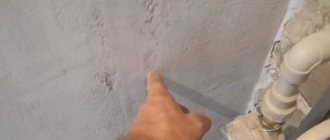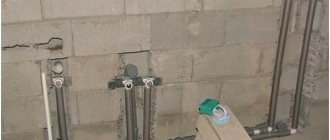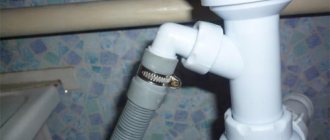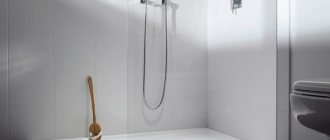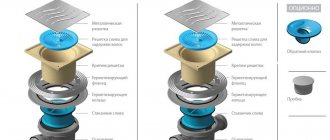05/21/2020 Read in 4 minutes.
Residents of apartment buildings often face the problem of water leaks in the bathroom. If neighbors are injured, you often have to pay for the finishing work. In order to avoid a problematic situation when renovating an apartment, you should consider an emergency drain in the bathroom. It will allow excess water to be removed into the sewer system, which will provide good waterproofing to “wet” areas.
view album in new window
Device
The sewer drain consists of the following elements:
- The body is in the form of an oblong tube with an extension at the top. Performs the function of water drainage.
- Grille (the so-called front panel). Acts as a filter. The grate is the only element of the ladder that can be decorated. There are round/square/rectangular front panels.
- Siphon. Prevents the possibility of developing unfavorable odors. There are several types of siphons: with mechanical/dry/hydraulic seal. The most common is the water seal (it is made of durable materials such as steel or enameled aluminum to increase its service life).
- Seal and clamping elements.
Above is the main structure of the product. Various modifications and improvements to the design by various manufacturers are possible. For additional information, ask the store staff.
Dry seal device
It does not have the disadvantages of equipment with a water seal due to the fact that it is equipped with a special mechanism, which, subject to gravitational influence, tends to constantly occupy a position that blocks the sewer pipe. If water gets inside the drain, it will lower the valve down and easily enter the pipeline.
There are several variations of devices that differ in the principle of operation of the locking mechanism: membrane, float, pendulum and using the molecular memory of the material. In any case, dry seal equipment works very efficiently. An additional advantage of such a drain is the possibility of equipping it with a check valve, which will not allow waste water to return back into the room.
Classification
According to the material:
- Plastic. Plastic ladder is the most common type of product. Plastic parts are resistant to aggressive environments, are easy to clean, decorate, are lightweight and have a long service life. Plastic sewer products are intended for installation in residential premises.
- Cast iron. Suitable for rooms with harsh operating conditions. They have the greatest throughput feature. Installed in swimming pools and bathrooms.
- Made from stainless steel. Often used in medical, health, and public institutions where high hygienic standards are required.
By installation type:
- Vertical. The vertical product increases the throughput, but requires special conditions for installation.
- Horizontal. It is universal, does not require special conditions for installation, but at the same time the throughput is reduced.
Types of mechanism and materials for its manufacture
The bathroom systems we are interested in can be semi-automatic or automatic. The first type of drain has a small cable. It serves as a connector between the drain plug and the overflow device. Semi-automatic draining is used simply. When you need to open its hole, pull the cable and thereby lift the plug. Water from the font rushes into the sewer pipes.
A semi-automatic drain is inexpensive, looks quite attractive in appearance, and even a child can operate it correctly without any extra effort. The only disadvantage of this design is that the cable that lifts the plug may break with frequent use. However, this problem is inherent exclusively to inexpensive mechanisms. Automatic draining is structurally more complex. It functions differently. To lift the cork, you need to press on it. And the automation itself will open the entrance to the drain hole! The mechanism that provides this opportunity is mounted in the plug itself. The disadvantage of the system is the need to bend down to the bottom of the bath to press the lid.
Semi-automatic drain
Recently, another type of automatic drainage with a special filling device has been actively used. Its installation is recommended for hot tubs without a mixer. This mechanism connects the water supply pipe to the overflow. This allows you to draw water into the bathtub using an overflow device. Drain-overflow systems are made of metal and chrome-plated brass, as well as polyethylene and various types of polypropylene. Metal products are short-lived in use. Now they are practically not used.
The most expensive is the brass siphon. He looks great. It is used when they want to create a special interior in the bathroom. But according to some indicators (in particular, the level of resistance to mechanical loads), brass products are inferior to cheaper and at the same time more resistant polypropylene and plastic structures.
Product selection criteria
Before purchasing ladders in a specialized store, you need to know the criteria for selecting a product.
- Size. The size is determined by the average volume of waste. Consult with the seller, provide the necessary information about the future use of the ladder. Often, medium-sized drains are selected for domestic purposes (for example, in a bathroom).
- Material. The selection of material depends on the initial needs and purposes of operation. For domestic purposes, it is recommended to select plastic and stainless steel; for more serious structures (for example, public swimming pools) - cast iron.
- Equipment. Pay special attention to the built-in siphon, bushing section, throughput, and maximum load on the drain. It is welcome to have instructions for installation and operation of the finished product. Check the quality, integrity of the packaging, and any damage to the product before paying for your purchase.
- Drainage diameter. The recommended diameter for residential buildings is 50 mm, for public places - 100 mm.
For more information, contact your hardware store sales consultant. You will be provided with a free consultation taking into account your individual requirements and wishes for the finished product.
Why is an emergency drain needed?
A drain in the bathroom floor rids the room of excess moisture and puddles on the tiles, eliminates the smell of dampness, and prevents the formation of mold. Puddles that constantly remain after water procedures negatively affect walls and plumbing, and also provoke the proliferation of pathogens. Installing an emergency drain allows you to keep the bathroom sufficiently dry and free of foreign odors.
- The bathroom is planned to have a shower and additional insulation from water is needed. Or the cabin has no sides or curtains, so the drain, along with fulfilling its direct function, provides protection in case of a flood.
- Additional insurance in case of flooding in the apartment. This reason is especially relevant in apartment buildings, when the apartment is not on the ground floor. People often think about installing an emergency drain if they plan to install a Jacuzzi in the bathroom.
Price policy
You can purchase the finished product at a hardware store. The option of purchasing online is also allowed. Purchasing online is recommended for advanced users who know the principles of product selection and installation. Beginners are recommended to have a preliminary consultation with the seller to determine the future material and the main parameters of the product.
The cost of ladders varies depending on the following components:
- manufacturer's pricing policy;
- finished product material;
- equipment;
- scope of purpose (sewage of a public place or residential premises requires different types and characteristics of the finished product).
Sewer drains, depending on the parameters indicated above, can be purchased from 700 rubles.
Many people prefer to create their own bathroom design. Now you can move away from the usual models of shower cabins and bathtubs and create an original shower cabin with an unusual shape and finish. Creating a pallet yourself is not too difficult a task, but in order for everything to work without failures, it is necessary to equip a sewer drain. A sewer drain will help with this, which must be correctly installed in the floor.
These parts can differ in different ways; first of all, they can be divided by material
, from which ladders can be made. Each of them has its own characteristics, pros and cons, and their purpose also differs:
Ladders may differ according to other criteria
:
- The vertical
ladder has a large throughput system, but due to this, special conditions for installation are required. - Horizontal
drains can be used in all rooms, regardless of the number of floors in the building; they are used much more often.
The size of the ladder also changes
, its height depends on the model and varies from 75 mm to 180 mm. The shape of the ladder, or more precisely, its upper grille, can be round, square or rectangular.
All ladders have a similar structure, which includes the following elements
:
Shower drain under tiles: installation features
Installation of an emergency drain requires careful step-by-step multi-layer preparation of the floor. In addition, it is necessary to mark the position of the future drain, calculate the distance from the walls if you plan to cover the walls with tiles, and the height of the floor layers in order to install the drain no higher than the finishing layer.
Photo 4. Installation diagram of an emergency shower drain.
1. Rough concrete screed. To complete the first layer, it is necessary to take care of thermal insulation, since applying the screed to a cold concrete floor can result in its deformation and subsequent destruction. Expanded polystyrene is usually used as insulation.
2. Waterproofing the floor surface extending onto the walls. For this purpose, polyacrylic plastic is used; it is this that creates a waterproof elastic layer, which must be overlapped on the walls.
3. Screed with a slope towards the drain. Before pouring, it is necessary to install guides made of polymer or wood.
4. Finish coating. At this stage, the tiles are laid first on the floor to eliminate the possibility of leaks, then on the walls.
Photo 5: The shower floor slabs should lead to the drain.
Gangway selection criteria
Selecting a ladder is a responsible task, since dismantling it
extremely difficult.
To replace an already installed drain, you will have to disassemble the floor covering and remove the screed. First of all, when choosing a product, its size is taken into account; it is usually determined based on the average volume of waste. with a good throughput system
are usually suitable for shower stalls The material of the ladder does not matter much; plastic
.
But you can also opt for stainless steel
; it does not corrode, is durable and reliable.
Heavy cast iron
structures are usually not installed in apartments. The diameter and direction of wastewater discharge is very important.
To select a drain for subsequent installation in a shower system, you can select the optimal characteristics
, but some points need to be taken into account on an individual basis.
How to connect a bathtub to the water supply
After installing the sewer connection, the mixer is installed. With its help, the bath will be connected to the water supply. Water outlets are holes in the wall to which outlets from the central riser are connected.
Mixer design
- FUM tape is wound around the eccentrics. Afterwards, they are screwed into the socket with neat, smooth movements. The inside of the “boots” is not sealed - there will be a gasket that will do an excellent job of protecting against leaks. Only after this are glasses or reflectors installed on the open parts of the eccentrics;
- The mixer kit comes with special gaskets. They are attached to the protrusions of the eccentrics and the crane itself is mounted on top of them;
- A shower hose is connected to the mixer. Its fastenings are also sealed using rubber gaskets, and the threads are sealed with FUM tape. If desired, you can immediately install a holder for a shower “rain”;
- Then his work is checked. Be sure to inspect the eccentrics - nothing should drip from them. If water leaks from the connections, the parts of the structure need to be pressed more tightly.
The best way to check is to turn on the water and run half a bath. With such pressure, all weak connections will immediately show themselves. Detected leaky fasteners are tightened and treated with sealants.
Sewer drain installation technology
The very first and most important condition for installing any drain is the slope of the floor covering. It must be made in such a way that wastewater can flow gradually and easily into the drain. Usually the drain is installed in place of the shower stall
, therefore, many floor finishing is done with tiles. Rules for installing a sewer drain that must be followed:
- The drain grating must be flush
with the top floor covering. - Floor finishing begins directly from the ladder; tiles must be laid from it to the walls.
- All seams between tiles should be no more than 2 mm.
- Their grout is only moisture resistant.
Installation of the ladder has its own sequence
:
This option for installing a drain allows you to maintain the height of the floor in the bathroom at the same level as other rooms, so the work is quite labor-intensive. You can go another, simpler way, you need to build a wooden flooring
or
an iron frame
, the main thing is that it is durable. Next, the outlet from the drain to the sewer pipe is installed; it is also important to maintain the slope.
The elevation is done by constructing a screed; it is necessary to install the formwork,
lay waterproofing material and reinforcing mesh.
The ladder is installed so that its level is slightly higher than the formwork, that is, on a par with the facing material. Next, concrete is poured; you always need to control the slope of the pipe. After it hardens, the formwork is disassembled and finishing work is carried out.
Installing a drain yourself is not an easy task, but anyone can cope with it. It is important to strictly follow the rules for installing a sewer drain and the sequence of work.
What does an emergency floor drain consist of?
To drain water in an emergency, the following components are required:
- The drain is a special siphon, flat, designed for arranging construction pallets and drainage.
- Emergency outlet - a section of pipe connecting the drain to the sewer.
- Waterproofing substrate is a layer of special mastic that prevents moisture from entering the interfloor ceiling.
- Floor screed is a layer of concrete with which both the drain and the pipe outlet are poured. In addition, tiles can be laid directly on the screed itself.
Of course, it is worth noting that the drain is the most important element of the emergency drain, so the reliability of the entire structure depends on its choice. The drain siphon grid is most often made of brass, stainless steel or plastic. Therefore, it will not be difficult to choose it to suit your bathroom design. But the internal structure may have significant differences.
Types and features of sewer drains
These parts can differ in various ways; first of all, they can be divided by material. from which ladders can be made. Each of them has its own characteristics, pros and cons, and their purpose also differs:
The ladders may differ according to other criteria:
- The vertical ladder has a large throughput system, but due to this, special conditions for installation are required.
- Horizontal drains can be used in all rooms, regardless of the number of floors in the building; they are used much more often.
The size of the ladder also changes. its height depends on the model and varies from 75 mm to 180 mm. The shape of the ladder, or more precisely, its upper grille, can be round, square or rectangular.
All ladders have a similar structure, which includes the following elements:
Preserving the washing machine for the winter
- To be honest, maybe I was wrong with the section, but.
- Eg: how is it possible to drain all the water from a washing machine?
kvinfo wrote: Ex: how is it possible to drain all the water from a washing machine.
Will she spend the winter outside with you?? Washing machines at factories are tested through a full cycle, and therefore even new washing machines always have residual water. And not a single manufacturer even thought about the question of “draining all the water”, because... this is completely unnecessary.
Well, almost, basically. In winter, the dacha is not heated, minus 20 outside, respectively minus 20 in the house. On the other hand, the manufacturer must consider that its products can be transported at sub-zero temperatures. There must be a traffic jam.
kvinfo wrote: how is it possible to drain all the water from a washing machine.
Option 1. Unscrew the filter cover. Option 2. On new models, near the filter cover there is a tube with a plug for draining water; in this case, remove the plug. Option 3. Lower the drain hose below the level of the tank (and pump) of the machine; the water should drain by gravity. Option 4. Turn the machine over so that the loading hatch-door is at the bottom, open the door and lightly rock the machine from side to side until the water is completely drained through the hatch.
In preparation for winter, I drain the water from the SM standing in a bathhouse in the village through an open filter, slightly tilting the SM forward. So far there have been no jambs.
In a similar case (SM in an unheated!) dacha, I proceed as follows:
- I drain the water from the bottom filter, first placing a low container down.
- I disconnect the drain hose from the siphon and blow hard into the tube. At the same time, a decent amount of water splashes out of the filter.
I wrap the filter back and attach the drain hose to the siphon.
7 years - normal flight.
! Disconnect the supply hose at the water supply valve, turn on the washing program, and when the water filling phase begins (almost immediately), blow out the inlet valve. To speed up the process, drain the water from the supply hose first (by unscrewing it completely and then putting it back on the machine).
THANKS A LOT. EVERYONE.
so as not to create a new topic, the washing machine refused to be easily prepared for winter and more alcohol was poured into it
What about the dishwasher? last winter I pumped it out with a pump and filled it with 0.5 alcohol, this year I repeated the algorithm, but it’s a pain in the ass to look for alcohol
DV1 wrote: 4th option. Turn the machine over so that the loading hatch-door is at the bottom, open the door and lightly rock the machine from side to side until the water is completely drained through the hatch.
the first three options are ok, this one is undesirable, because... the door/programmer may be broken.
Barca wrote: this one is undesirable because... the door/programmer may be broken.
No, well, if you hold the machine suspended and swing it with light movements, then in theory it shouldn’t break. Movements should be light. Under no circumstances should the machine be swung from side to side, much less up and down, with a strong amplitude.
I imagined people pumping a machine up and down with a large amplitude
This method has several disadvantages:
- The car is heavy and you can’t do this alone unless you have strong strength.
- In general, it is not advisable to tilt the car so much, because... water may (unlikely, but still) get on the control board and then you, in turn, can get into money.
- And last but not least. The machine is designed so that there is practically no water left in the tank. There is water only in the pump and in the pipe connecting the pump and the tank. The same method will lead to the fact that you will try to drive the water back into the tank, through which it will spread evenly. Sisyphus's work
Gangway selection criteria
Selecting a ladder is a responsible task, since dismantling it is extremely difficult. To replace an already installed drain, you will have to disassemble the floor covering and remove the screed. First of all, when choosing a product, its size is taken into account; it is usually determined based on the average volume of waste. Medium-sized drains with a good flow system are usually suitable for shower stalls.
The material of the ladder does not matter much; plastic is most often used. But you can also opt for stainless steel. it does not corrode, is durable and reliable. Heavy cast iron structures are usually not installed in apartments. The diameter and direction of wastewater discharge is very important.
To select a drain for subsequent installation in a shower system, you can select the optimal characteristics. but some points need to be taken into account on an individual basis.
What is a floor drain made of?
Before you equip a shower with a floor drain, decide on the components of such a system
This will be very important when installing it.
The drain allows water from the bathtub or shower to flow into the drain. The pipe outlet should be made of plastic with an outlet diameter of up to 50 mm to ensure normal wastewater flow. Corrugated pipe is also suitable, but many experts believe that for this device it is better to use a smooth pipe that cannot impede the flow of water. Also remember that the drain will be in the floor and access to the pipe will not be as easy as usual. The corrugation will impede drainage due to the following problems:
- hair stagnation in it;
- bars of soap;
- mud.
All this can subsequently lead to the entire sewer being clogged. And there is no urgent need to install corrugations; to install a drain in the floor, you will need such devices as:
- connections;
- adapters;
- couplings.
The outlet for the siphon must be straight and have an angle of 135 degrees with respect to the main pipe. Its slope should be 15 degrees relative to the drain. Thanks to these parameters, the floor drain will ensure the unimpeded flow of water from the bath or shower into the sewer.
How to organize water supply at your dacha in winter without problems
Most summer residents do not leave their plots for a long time even in winter: they come on weekends and holidays. Nowadays, people are so accustomed to comfortable conditions that they do not agree to draw water from a well with a bucket, wash dishes in a basin, or bathe in a trough. We need such a benefit of civilization as cold and hot water from the tap at any time of the year. But frosts test the strength not only of our health, but also of the creations of human hands.
How to organize water supply at your dacha in winter without problems
Perhaps you, too, have encountered problems with winter dacha water supply. We’ll talk about them, or rather about how to avoid them.
Of course, if you personally designed and built your dacha, then you took care in advance of the safety of the equipment and the uninterrupted operation of all systems at any time of the year. Fortunately, there are now many ways to protect water pipes from freezing: the latest thermal insulation materials or cable heating of pipes.
Cable heating. Photo from housechief.ru
What should those who bought a dacha building and are forced to use what they have do? How can you inexpensively and reliably protect ordinary utility lines in winter so that they do not freeze and fail?
There is an opinion that pipes laid below the soil freezing level are safe in winter. This is not entirely true. The degree of soil freezing is influenced by several factors: its density and humidity, duration and severity of frost. For example, for Central Russia, the recommended pipeline laying depth is 1.5 m. But, as practice in recent years shows, the freezing depth in February-March reaches 1.8 m.
If you are sure that your water supply is hidden at a safe depth, just drain the water from the heating system and you can safely leave for the city. The only advice in this case: leave the water flowing from the taps in a thin stream. As long as there is water movement through the pipes, the risk of them freezing is reduced significantly.
Leave the water to flow in a thin stream. Photo from the site bryansktoday.ru

